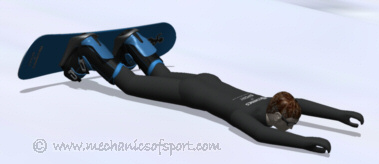Protective Clothing

Protective clothing is commonly used in snowboarding and can even make snowboarding more comfortable as well as safer. The most common cause of injury while snowboarding is catching an edge. This is where the downhill edge on the snowboard catches and digs into the snow, stopping the snowboard dead, and violently throwing the rider towards the ground. Because of this injuries to the upper body are more common, especially the wrists, head and ass. Although extremely few crashes result in seriously injury, crashing has to be expected, and serious injuries can happen.
Helmets
Helmets quite simply protect your head, and can easily make the difference between being concussed and not being concussed if you have caught an edge very badly. Modern helmets are very comfortable, and can have all sorts of vents to make sure you are not too hot or too cold, as well as ear pads that remove or even have speakers in them. There is a huge selection of helmets on the market today, so it should be possible to find a helmet you like whatever you are looking for. When choosing a helmet, you need to remember that it should be a snug fit, and not be able to move too much while it is on your head. This is very important as the helmet will not protect you properly if it is able to move to much. Head injuries are the second most common type of snowboard injury after wrist injuries, and whereas wearing a helmet might have looked a bit strange in the past, nowadays it's completely normal, and the sensible thing to do.
For more information about helmets please read the Ski Helmets page.
Wrist Guards
Wrist guards are basically supports that hold or limit the movement in your wrist, protecting them. Wrist injuries are the most common injury in snowboarding, as most people try to use their arms to cushion a crash, with their hands and wrists often seeing the full force of an impact. Wrist guards can come as separate supports that are worn under or over gloves, and can also be found built into some gloves. Although wrist guards are very effective at protecting your wrists, they are not perfect, firstly they reduce the movement in your wrist, which is good in a crash, but it can get in the way when it comes to normal tasks. Secondly if you crash hard enough wrist guards will just transmit the force further up your arm so that your arm breaks instead. All negatives taken into account though, they are still a very good idea, especially when learning to snowboard.
Padded Shorts
Padded shorts will not only protect you if you fall backwards, but can also help keep your ass warm and more comfortable when sitting on the snow. Most padded shorts have several pads in the key areas that you are most likely to hit if you fall, the coccyx, the ass cheeks, the hip bones, and the outside of your thighs. On some padded shorts all the pads are soft, while others might have a hard shell on the pads for places like the coccyx, and thighs. Padded shorts are highly recommended, as they will increase your comfort as well as your protection, being very useful to riders of all standards. Although wrist injuries are the most common serious injury, getting a sore ass is almost certainly the most common minor injury. Padded shorts won't take all the pain away, but they will make a big difference.
Back Protectors
Back protectors come in many forms, although generally they are an armadillo sort of construction that lies along the back of your spine. They can be separate garments with straps to keep them in place, or built into under jackets that can also have padding for your chest and shoulders, with some even covering the whole upper body providing elbow and forearm protection as well. Although back injuries aren't as common as others, it is one injury that you really want to avoid.
Knee and Elbow Pads
Although not used as commonly as other protective items, some people do find they have a habit of hitting their knees or elbows. Knee and elbow pads provide good protection for the knees and elbows, but they cover joints that have a large amount of movement, and a lot of people just don't find them comfortable enough to use regularly. Knee pads can also be useful if you spend any real amount of time kneeling on the snow, as they will keep your knees warmer and better cushioned.
Information on Jackets/Clothing, and Goggles can be found in the Ski Equipment Section.
On to the Snowboard Setup section.